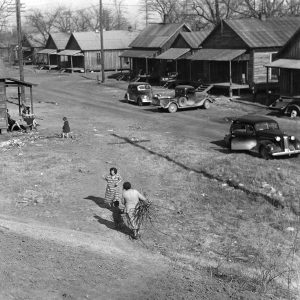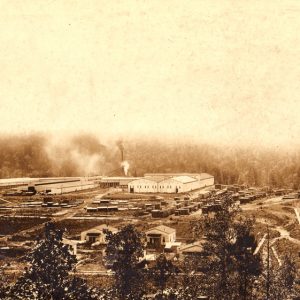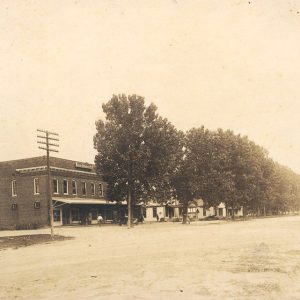calsfoundation@cals.org
Company Towns
Company towns are communities that are dependent on a single business for most if not all the functions of town life. Some company towns are owned by businesses, and each piece of property, from the homes to the schools to the stores, is made available for use by employees of the business and their families. Payments to reside in company-owned homes were often withheld directly from the pay of workers, and the use of “scrip” (company-issued money) at company-owned stores limited the purchasing power of the employees. Company towns have existed across Arkansas over the decades, established by a variety of industries, including timber and aluminum manufacturing.
Timber-related company towns were scattered throughout the southern, northeastern, and western portions of the state, with some continuing to exist in the twenty-first century. The Three States Lumber Company established Burdette (Mississippi County) in 1905 and began sawmill operations the following year. As trees were removed from the land, large-scale agricultural operations began. The lumber company slowly sold its land holdings in the area through the 1920s and 1930s.
The Dierks Lumber Company founded Mountain Pine (Garland County) in 1927 to support its growing timber operations in the county. The company provided homes for the sawmill workers, as well as a school, store, theater, and church. The town was incorporated in 1966. After Weyerhaeuser bought the Dierks Company in 1969, workers were given the opportunity to purchase their homes. Privatization of the company store followed. The mill closed in 2006, and Weyerhaeuser donated several buildings and land parcels to the city the following year. The Dierks Lumber Company also founded Blakely (Garland County) to support a sawmill processing timber as Blakely Dam was being constructed. Moving twice over the course of the community’s existence, the company-owned homes were also sold to employees in 1969 after the Dierks Company was purchased by Weyerhaeuser. Both Blakely and Mountain Pine continue to exist in the twenty-first century as communities.
Forester (Scott County) was founded in 1930 as a company town for the Caddo River Lumber Company. In addition to providing housing for workers, the company operated schools, churches, a theater, a post office, a drugstore, a barber/beauty shop, a twenty-eight-room hotel, a depot, a garage with car sales, a ballpark and stadium, a community hall, and a company store. The mill closed in 1952, and the entire community was demolished or the buildings moved.
Another former company town that no longer exists was Graysonia (Clark County). Founded in 1907, the town supported the operations of the Arkadelphia Lumber Company. The town included various amenities, including a movie theater, three hotels, and public utilities. The Great Depression led to the closure of the mill, and a later effort to use the site for cinnabar mining proved unsuccessful. By 1950, the population of the town was listed at zero.
Other timber-related company towns in Arkansas include Huttig (Union County), Trumann (Poinsett County), and Crossett (Ashley County). Crossett was founded by the Crossett Lumber Company in 1899 and incorporated in 1903. While the company owned and controlled much of the property in Crossett proper, nearby communities in Ashley County emerged to handle the growing population: North Crossett, South Crossett, and West Crossett.
Wilson (Mississippi County) began as a logging town but was transformed by its owner, Robert E. Lee Wilson, into a thriving agricultural community. Workers rented homes from the Lee Wilson Company and could access healthcare and other resources, all housed in English Tudor–inspired buildings surrounding a square with cottonwood trees.
Bauxite (Saline County) operated as a company town based on the aluminum industry, as a facility of Alcoa operated in the community. The population boomed during both World War I and World War II but dropped after the end of hostilities. Alcoa moved many operations overseas, and the company stopped offering services in the town in 1969. The remaining residents incorporated in 1973, and the community continues to exist in the twenty-first century.
Founded as a company town by the Central Coal and Coke Company in 1898, Bonanza (Sebastian County) served the workers of three coal mines. A combination of company-owned homes and a general store coexisted with a number of private businesses, including numerous saloons. As the coal resources in the area became exhausted, the mines shut down. With the closure of Mine No. 26 in 1919, the Central Coal and Coke Company dismantled the company-owned buildings in the town and moved them to a new location in Oklahoma. A period of population decline followed, only to be reversed by growing urban sprawl from nearby Fort Smith (Sebastian County).
Okay (Howard County) existed to support the operations of the Ideal Cement Company. Opened in 1929, the community included houses, a store, and various recreational facilities. Never a large town, the community and plant were sold several times over the decades, and by 1977, only two residents remained. The plant closed in 1993, and the area was abandoned.
Numerous other temporary settlements operated by companies existed throughout Arkansas over the decades. These communities, however temporary they might have been, were critical to the development of the state.
For additional information:
Balogh, George Walter. “Crossett: The Community, the Company, and Change.” Arkansas Historical Quarterly 44 (Summer 1985): 156–174.
———. Entrepreneurs in the Lumber Industry: Arkansas, 1881–1963. New York: Garland Publishing, Inc., 1995.
Buckner, John W. Wilderness Lady: A History of Crossett, Arkansas. Little Rock: Rose Publishing Company, 1979.
Burns, Richard Allen. “The Shotgun Houses of Trumann, Arkansas.” Arkansas Review: A Journal of Delta Studies 33 (April 2002): 44–51.
Darling, O. H. “Doogie,” and Don C. Bragg. “The Early Mills, Railroads, and Logging Camps of the Crossett Lumber Company.” Arkansas Historical Quarterly 67 (Summer 2008): 107–140.
Dierks Lumber and Coal Company Records. Riley-Hickingbotham Library Archives and Special Collections. Ouachita Baptist University, Arkadelphia, Arkansas.
Forrester, Jami Marie. “From Swamp Forest to Cotton: Three States Lumber Company and the Development of Burdette, Arkansas, in the Early Twentieth Century.” PhD diss., University of Arkansas, 2011.
Lee Wilson & Company Archives. Arkansas Digital Library. http://libinfo.uark.edu/SpecialCollections/ardiglib/leewilson/default.asp (accessed January 5, 2024).
“Memories of Graysonia.” Clark County Historical Journal 1 (Spring 1974): 38–48.
Moyers, David B. “Trouble in a Company Town: The Crossett Strike of 1940.” Arkansas Historical Quarterly 48 (Spring 1989): 34–56.
Richter, Wendy. “The Birth of a Company Town.” The Record 42 (2001): 1–27.
Richter, Wendy, ed. Clark County, Arkansas: Past and Present. Arkadelphia, AR: Clark County Historical Association, 1992.
Smith, Kenneth L. Sawmill: The Story of Cutting the Last Virgin Forest East of the Rockies. Fayetteville: University of Arkansas Press, 1986.
Thompson, Margaret Ponder. A Village in Time: An Oral History of Okay, Arkansas. Little Rock: August House, 1997.
Whayne, Jeannie. Delta Empire: Lee Wilson and the Transformation of Agriculture in the New South. Baton Rouge: Louisiana State University Press, 2011.
———. A New Plantation South: Land, Labor, and Federal Favor in Twentieth-Century Arkansas. Charlottesville: University of Virginia Press, 1996.
———. “Robert E. Lee Wilson and the Making of a Post Civil War Plantation System.” In The Southern Elite and Social Change: Essays in Honor of Willard B. Gatewood, Jr., edited by Randy Finley and Thomas DeBlack. Fayetteville: University of Arkansas Press, 2002.
Wheeler, Frances Carroll. “For Sale: Huttig Company Town Since 1904, Gets Lift through Offer by Olin.” Arkansas Gazette, February 7, 1954, p. 1F.
David Sesser
Southeastern Louisiana University
 Coal Mining Settlement
Coal Mining Settlement  Forester Company Store
Forester Company Store  Graysonia Timber Mill
Graysonia Timber Mill  Huttig Street Scene
Huttig Street Scene  Okay Construction
Okay Construction  Wilson Street Scene
Wilson Street Scene 



Comments
No comments on this entry yet.